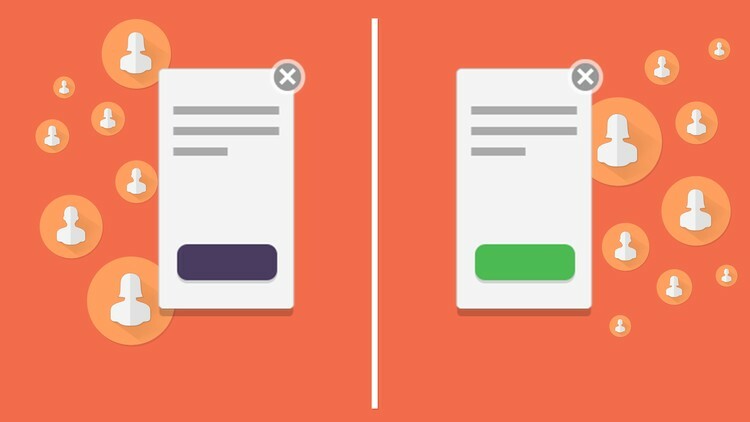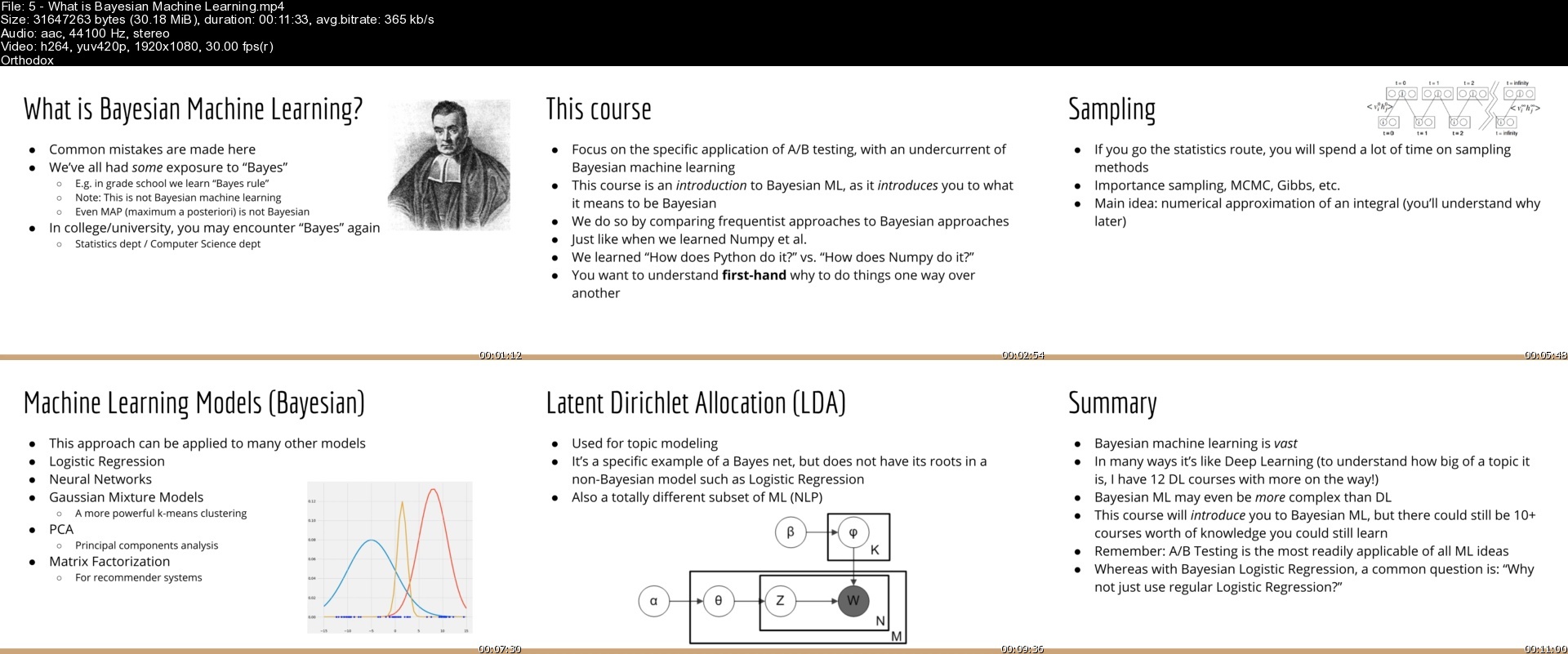
Bayesian Machine Learning in Python: A/B Testing (updated 11/2022)
Last updated 11/2022
MP4 | Video: h264, 1280x720 | Audio: AAC, 44.1 KHz
Language: English | Size: 2.59 GB | Duration: 10h 24m
Data Science, Machine Learning, and Data Analytics Techniques for Marketing, Digital Media, Online Advertising, and More
What you'll learn
Use adaptive algorithms to improve A/B testing performance
Understand the difference between Bayesian and frequentist statistics
Apply Bayesian methods to A/B testing
Requirements
Probability (joint, marginal, conditional distributions, continuous and discrete random variables, PDF, PMF, CDF)
Python coding with the Numpy stack
Description
This course is all about A/B testing.A/B testing is used everywhere. Marketing, retail, newsfeeds, online advertising, and more.A/B testing is all about comparing things.If you're a data scientist, and you want to tell the rest of the company, "logo A is better than logo B", well you can't just say that without proving it using numbers and statistics.Traditional A/B testing has been around for a long time, and it's full of approximations and confusing definitions.In this course, while we will do traditional A/B testing in order to appreciate its complexity, what we will eventually get to is the Bayesian machine learning way of doing things.First, we'll see if we can improve on traditional A/B testing with adaptive methods. These all help you solve the explore-exploit dilemma.You'll learn about the epsilon-greedy algorithm, which you may have heard about in the context of reinforcement learning.We'll improve upon the epsilon-greedy algorithm with a similar algorithm called UCB1.Finally, we'll improve on both of those by using a fully Bayesian approach.Why is the Bayesian method interesting to us in machine learning?It's an entirely different way of thinking about probability.It's a paradigm shift.You'll probably need to come back to this course several times before it fully sinks in.It's also powerful, and many machine learning experts often make statements about how they "subscribe to the Bayesian school of thought".In sum - it's going to give us a lot of powerful new tools that we can use in machine learning.The things you'll learn in this course are not only applicable to A/B testing, but rather, we're using A/B testing as a concrete example of how Bayesian techniques can be applied.You'll learn these fundamental tools of the Bayesian method - through the example of A/B testing - and then you'll be able to carry those Bayesian techniques to more advanced machine learning models in the future.See you in class!"If you can't implement it, you don't understand it"Or as the great physicist Richard Feynman said: "What I cannot create, I do not understand".My courses are the ONLY courses where you will learn how to implement machine learning algorithms from scratchOther courses will teach you how to plug in your data into a library, but do you really need help with 3 lines of code?After doing the same thing with 10 datasets, you realize you didn't learn 10 things. You learned 1 thing, and just repeated the same 3 lines of code 10 times...Suggested Prerequisites:Probability (joint, marginal, conditional distributions, continuous and discrete random variables, PDF, PMF, CDF)Python coding: if/else, loops, lists, dicts, setsNumpy, Scipy, MatplotlibWHAT ORDER SHOULD I TAKE YOUR COURSES IN?:Check out the lecture "Machine Learning and AI Prerequisite Roadmap" (available in the FAQ of any of my courses, including the free Numpy course)UNIQUE FEATURESEvery line of code explained in detail - email me any time if you disagreeNo wasted time "typing" on the keyboard like other courses - let's be honest, nobody can really write code worth learning about in just 20 minutes from scratchNot afraid of university-level math - get important details about algorithms that other courses leave out
Overview
Section 1: Introduction and Outline
Lecture 1 What's this course all about?
Lecture 2 Where to get the code for this course
Lecture 3 How to succeed in this course
Section 2: The High-Level Picture
Lecture 4 Real-World Examples of A/B Testing
Lecture 5 What is Bayesian Machine Learning?
Section 3: Bayes Rule and Probability Review
Lecture 6 Review Section Introduction
Lecture 7 Probability and Bayes' Rule Review
Lecture 8 Calculating Probabilities - Practice
Lecture 9 The Gambler
Lecture 10 The Monty Hall Problem
Lecture 11 Maximum Likelihood Estimation - Bernoulli
Lecture 12 Click-Through Rates (CTR)
Lecture 13 Maximum Likelihood Estimation - Gaussian (pt 1)
Lecture 14 Maximum Likelihood Estimation - Gaussian (pt 2)
Lecture 15 CDFs and Percentiles
Lecture 16 Probability Review in Code
Lecture 17 Probability Review Section Summary
Lecture 18 Beginners: Fix Your Understanding of Statistics vs Machine Learning
Lecture 19 Suggestion Box
Section 4: Traditional A/B Testing
Lecture 20 Confidence Intervals (pt 1) - Intuition
Lecture 21 Confidence Intervals (pt 2) - Beginner Level
Lecture 22 Confidence Intervals (pt 3) - Intermediate Level
Lecture 23 Confidence Intervals (pt 4) - Intermediate Level
Lecture 24 Confidence Intervals (pt 5) - Intermediate Level
Lecture 25 Confidence Intervals Code
Lecture 26 Hypothesis Testing - Examples
Lecture 27 Statistical Significance
Lecture 28 Hypothesis Testing - The API Approach
Lecture 29 Hypothesis Testing - Accept Or Reject?
Lecture 30 Hypothesis Testing - Further Examples
Lecture 31 Z-Test Theory (pt 1)
Lecture 32 Z-Test Theory (pt 2)
Lecture 33 Z-Test Code (pt 1)
Lecture 34 Z-Test Code (pt 2)
Lecture 35 A/B Test Exercise
Lecture 36 Classical A/B Testing Section Summary
Section 5: Bayesian A/B Testing
Lecture 37 Section Introduction: The Explore-Exploit Dilemma
Lecture 38 Applications of the Explore-Exploit Dilemma
Lecture 39 Epsilon-Greedy Theory
Lecture 40 Calculating a Sample Mean (pt 1)
Lecture 41 Epsilon-Greedy Beginner's Exercise Prompt
Lecture 42 Designing Your Bandit Program
Lecture 43 Epsilon-Greedy in Code
Lecture 44 Comparing Different Epsilons
Lecture 45 Optimistic Initial Values Theory
Lecture 46 Optimistic Initial Values Beginner's Exercise Prompt
Lecture 47 Optimistic Initial Values Code
Lecture 48 UCB1 Theory
Lecture 49 UCB1 Beginner's Exercise Prompt
Lecture 50 UCB1 Code
Lecture 51 Bayesian Bandits / Thompson Sampling Theory (pt 1)
Lecture 52 Bayesian Bandits / Thompson Sampling Theory (pt 2)
Lecture 53 Thompson Sampling Beginner's Exercise Prompt
Lecture 54 Thompson Sampling Code
Lecture 55 Thompson Sampling With Gaussian Reward Theory
Lecture 56 Thompson Sampling With Gaussian Reward Code
Lecture 57 Exercise on Gaussian Rewards
Lecture 58 Why don't we just use a library?
Lecture 59 Nonstationary Bandits
Lecture 60 Bandit Summary, Real Data, and Online Learning
Lecture 61 (Optional) Alternative Bandit Designs
Section 6: Bayesian A/B Testing Extension
Lecture 62 More about the Explore-Exploit Dilemma
Lecture 63 Confidence Interval Approximation vs. Beta Posterior
Lecture 64 Adaptive Ad Server Exercise
Section 7: Practice Makes Perfect
Lecture 65 Intro to Exercises on Conjugate Priors
Lecture 66 Exercise: Die Roll
Lecture 67 The most important quiz of all - Obtaining an infinite amount of practice
Section 8: Setting Up Your Environment (FAQ by Student Request)
Lecture 68 Anaconda Environment Setup
Lecture 69 How to install Numpy, Scipy, Matplotlib, Pandas, IPython, Theano, and TensorFlow
Section 9: Extra Help With Python Coding for Beginners (FAQ by Student Request)
Lecture 70 How to Code by Yourself (part 1)
Lecture 71 How to Code by Yourself (part 2)
Lecture 72 Proof that using Jupyter Notebook is the same as not using it
Lecture 73 Python 2 vs Python 3
Section 10: Effective Learning Strategies for Machine Learning (FAQ by Student Request)
Lecture 74 How to Succeed in this Course (Long Version)
Lecture 75 Is this for Beginners or Experts? Academic or Practical? Fast or slow-paced?
Lecture 76 Machine Learning and AI Prerequisite Roadmap (pt 1)
Lecture 77 Machine Learning and AI Prerequisite Roadmap (pt 2)
Section 11: Appendix / FAQ Finale
Lecture 78 What is the Appendix?
Lecture 79 BONUS
Students and professionals with a technical background who want to learn Bayesian machine learning techniques to apply to their data science work
Homepage
https://anonymz.com/?https://www.udemy.com/course/bayesian-machine-learning-in-python-ab-testing/

https://k2s.cc/file/e83a2d8ad5db0/Bayesian_Machine_Learning_in_Python_AB_Testing.rar
https://nitroflare.com/view/BFB7B0B19ADAC96/Bayesian_Machine_Learning_in_Python_AB_Testing.rar
https://rapidgator.net/file/4823f1842803af0ab991d787d00f137c/Bayesian_Machine_Learning_in_Python_AB_Testing.rar.html

